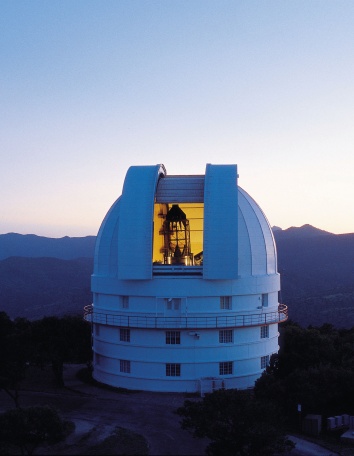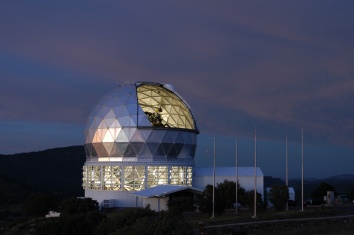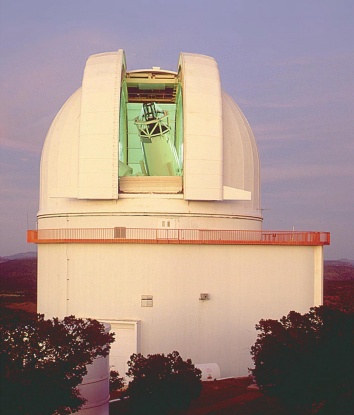Probing the Secrets of Dead Stars and Planetary Remnants from McDonald Observatory
17 December 2021
FORT DAVIS, Texas — In the course of research for his PhD, Zach Vanderbosch spent nearly 300 nights studying the heavens from telescopes at The University of Texas at Austin’s McDonald Observatory. Later this month, he will receive his doctorate for his research into the dead stars known as white dwarfs, and the orbiting disks of debris made up of these stars’ former planets.
McDonald Observatory provides UT Austin astronomy graduate students with valuable and unprecedented access to research facilities needed to complete their research.
“I focused on a couple of projects that required a large amount of observational data, which really could not have been done anywhere else,” Vanderbosch said, “without taking much longer. The observations would have to be spread out over many more years.”
Vanderbosch’s research is focused on white dwarf stars. A white dwarf is the burnt-out remnant of a Sun-like star that’s exhausted all of its nuclear fuel and so no longer burns lighter chemical elements into heavier ones in its core.
It’s a multi-step process for a Sun-like star to become a white dwarf. When the nuclear fusion stops, first the star’s gaseous atmosphere puffs up hugely into space. In its massive expansion, in which the star becomes a so-called red giant, it can engulf and destroy any planets orbiting too closely.
Over time, the red giant’s massively expanded atmosphere dissipates, leaving behind just the star’s core. This is the white dwarf. About the size of Earth with the mass of the Sun, this remnant will slowly cool off over billions of years.
Astronomers study white dwarfs for many reasons, including providing limits on the age of our galaxy and the universe itself.
Vanderbosch wanted to identify more examples of two rare types of white dwarfs, to provide all astronomers with more examples of these types for future research.
The first type he was searching for are pulsating helium atmosphere white dwarfs. Their light output varies over time, and studies of the pulsation rates help astronomers decode the interior structure of the star (much like a geologist studies the interior structure of the Earth by studying vibrations from earthquakes). Understanding a white dwarf’s interior leads to discoveries about its evolution.
Only a small number of these pulsating helium atmosphere white dwarfs — about two dozen — were known when Vanderbosch started his research.
The second type of rare white dwarf he wanted to find are those orbited by disks of planetary debris. Only a single example of such a white dwarf had been found before.
For his hunt to find more of these two types, Vanderbosch started with a sample of stars a few other missions had identified as likely white dwarf candidates. These came from the Gaia satellite and the Zwicky Transient Facility at Palomar Observatory in California.
He followed up on these stars in detail from McDonald Observatory. For a large portion of the 272 nights he observed at telescopes between 2015 and 2021, he studied these candidates, mostly with McDonald Observatory’s 2.1-meter Otto Struve Telescope.
“The best thing about the 2.1-meter is we have access to so much observing time on a reliable telescope and instrument,” Vanderbosch said. “To find rare and interesting types of variable white dwarfs often requires sifting through the weeds, so to speak, which can be time consuming. Fortunately, though, even the weeds are interesting at times, and we made many unexpected and exciting discoveries throughout our observing campaigns.”
Vanderbosch made use of the wide variety of observing capabilities at the observatory for other aspects of his research. He used the Hobby-Eberly Telescope, the 2.7-meter Harlan J. Smith Telescope, and several smaller telescopes to study the white dwarfs in different ways.
By the end of his work, Vanderbosch nearly doubled the number of pulsating helium atmosphere white dwarfs known to astronomers, raising the count from 26 to 45.
He and collaborators also increased the count of known white dwarfs orbited by planetary debris from one to seven. Understanding more about planetary debris orbiting white dwarfs is a hot topic, as astronomers continue to debate whether this will be Earth’s fate when the Sun becomes a red giant, and ultimately a white dwarf, billions of years from now.
The published research paper on white dwarfs orbited by planetary debris was headed up by Joseph Guidry, an undergraduate student Vanderbosch supervised. He and his PhD supervisors, Professor Don Winget and Assistant Professor of Practice Mike Montgomery, have a strong interest in supporting undergraduate research.
Vanderbosch will receive his doctorate this month. He is now working as a post-doctoral astronomer at Caltech in Pasadena, California, digging deeper into the Zwicky Transient Facility survey for more exciting white dwarf discoveries.
— END —
Media Contact:
Rebecca Johnson, Communications Mgr.
McDonald Observatory
The University of Texas at Austin
512-475-6763








